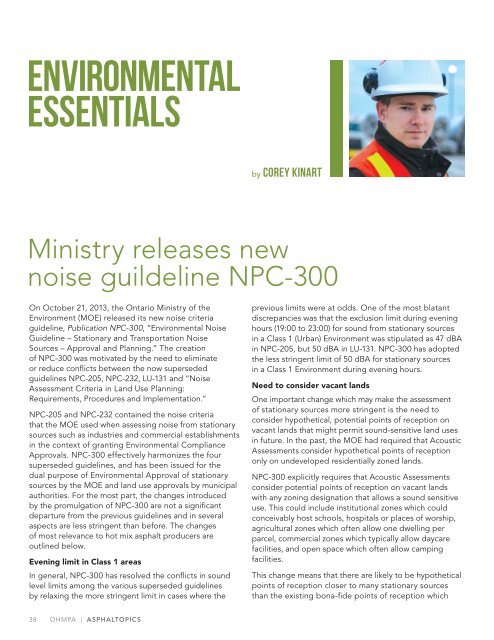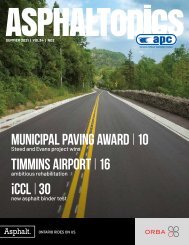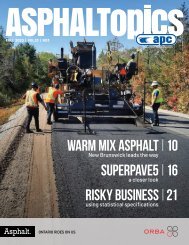ASPHALTopics | Spring 2014 | VOL 27 | NO 1
Create successful ePaper yourself
Turn your PDF publications into a flip-book with our unique Google optimized e-Paper software.
ENVIRONMENTAL<br />
ESSENTIALS<br />
by Corey Kinart<br />
Ministry releases new<br />
noise guildeline NPC-300<br />
On October 21, 2013, the Ontario Ministry of the<br />
Environment (MOE) released its new noise criteria<br />
guideline, Publication NPC-300, “Environmental Noise<br />
Guideline – Stationary and Transportation Noise<br />
Sources – Approval and Planning.” The creation<br />
of NPC-300 was motivated by the need to eliminate<br />
or reduce conflicts between the now superseded<br />
guidelines NPC-205, NPC-232, LU-131 and “Noise<br />
Assessment Criteria in Land Use Planning:<br />
Requirements, Procedures and Implementation.”<br />
NPC-205 and NPC-232 contained the noise criteria<br />
that the MOE used when assessing noise from stationary<br />
sources such as industries and commercial establishments<br />
in the context of granting Environmental Compliance<br />
Approvals. NPC-300 effectively harmonizes the four<br />
superseded guidelines, and has been issued for the<br />
dual purpose of Environmental Approval of stationary<br />
sources by the MOE and land use approvals by municipal<br />
authorities. For the most part, the changes introduced<br />
by the promulgation of NPC-300 are not a significant<br />
departure from the previous guidelines and in several<br />
aspects are less stringent than before. The changes<br />
of most relevance to hot mix asphalt producers are<br />
outlined below.<br />
Evening limit in Class 1 areas<br />
In general, NPC-300 has resolved the conflicts in sound<br />
level limits among the various superseded guidelines<br />
by relaxing the more stringent limit in cases where the<br />
previous limits were at odds. One of the most blatant<br />
discrepancies was that the exclusion limit during evening<br />
hours (19:00 to 23:00) for sound from stationary sources<br />
in a Class 1 (Urban) Environment was stipulated as 47 dBA<br />
in NPC-205, but 50 dBA in LU-131. NPC-300 has adopted<br />
the less stringent limit of 50 dBA for stationary sources<br />
in a Class 1 Environment during evening hours.<br />
Need to consider vacant lands<br />
One important change which may make the assessment<br />
of stationary sources more stringent is the need to<br />
consider hypothetical, potential points of reception on<br />
vacant lands that might permit sound-sensitive land uses<br />
in future. In the past, the MOE had required that Acoustic<br />
Assessments consider hypothetical points of reception<br />
only on undeveloped residentially zoned lands.<br />
NPC-300 explicitly requires that Acoustic Assessments<br />
consider potential points of reception on vacant lands<br />
with any zoning designation that allows a sound sensitive<br />
use. This could include institutional zones which could<br />
conceivably host schools, hospitals or places of worship,<br />
agricultural zones which often allow one dwelling per<br />
parcel, commercial zones which typically allow daycare<br />
facilities, and open space which often allow camping<br />
facilities.<br />
This change means that there are likely to be hypothetical<br />
points of reception closer to many stationary sources<br />
than the existing bona-fide points of reception which<br />
38 OHMPA | ASPHALTOPICS


















